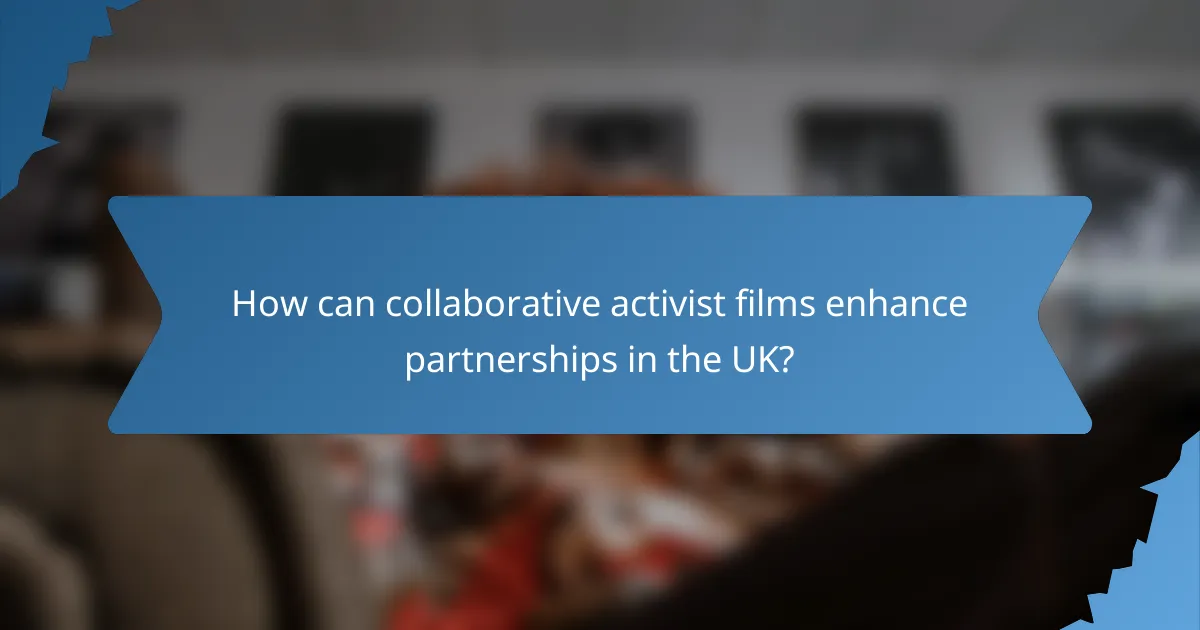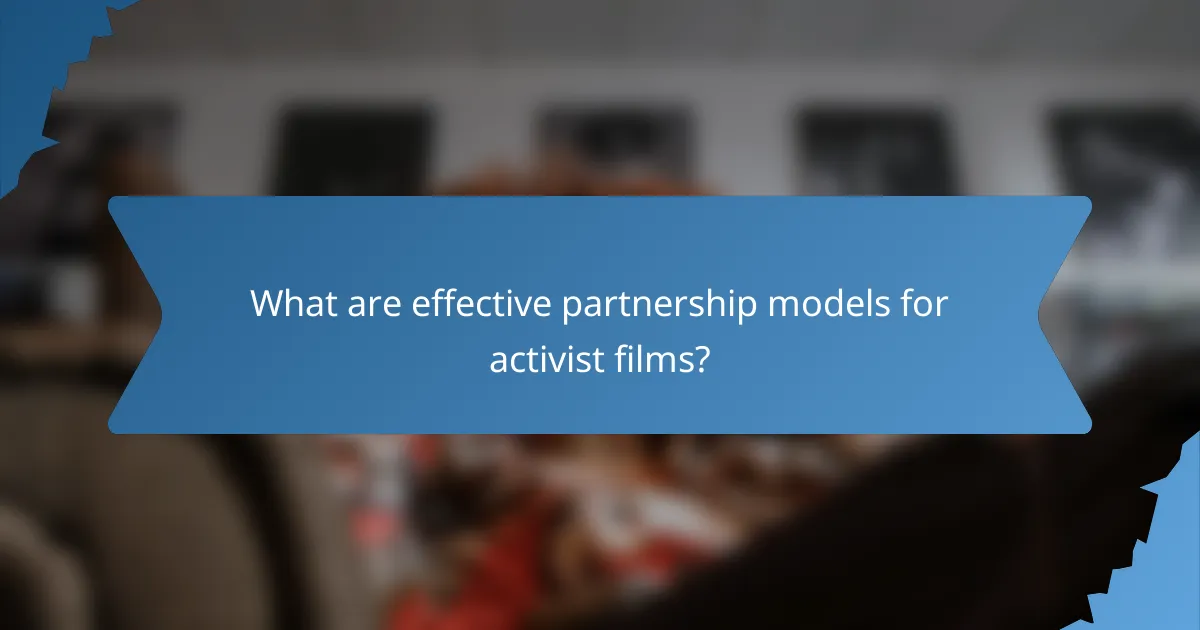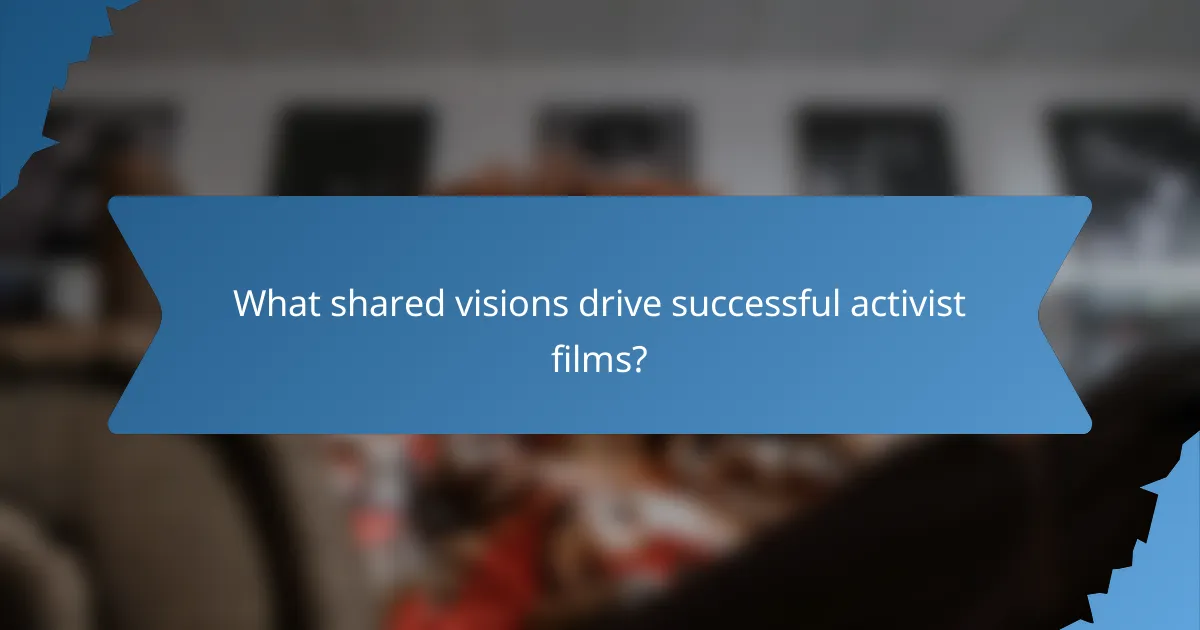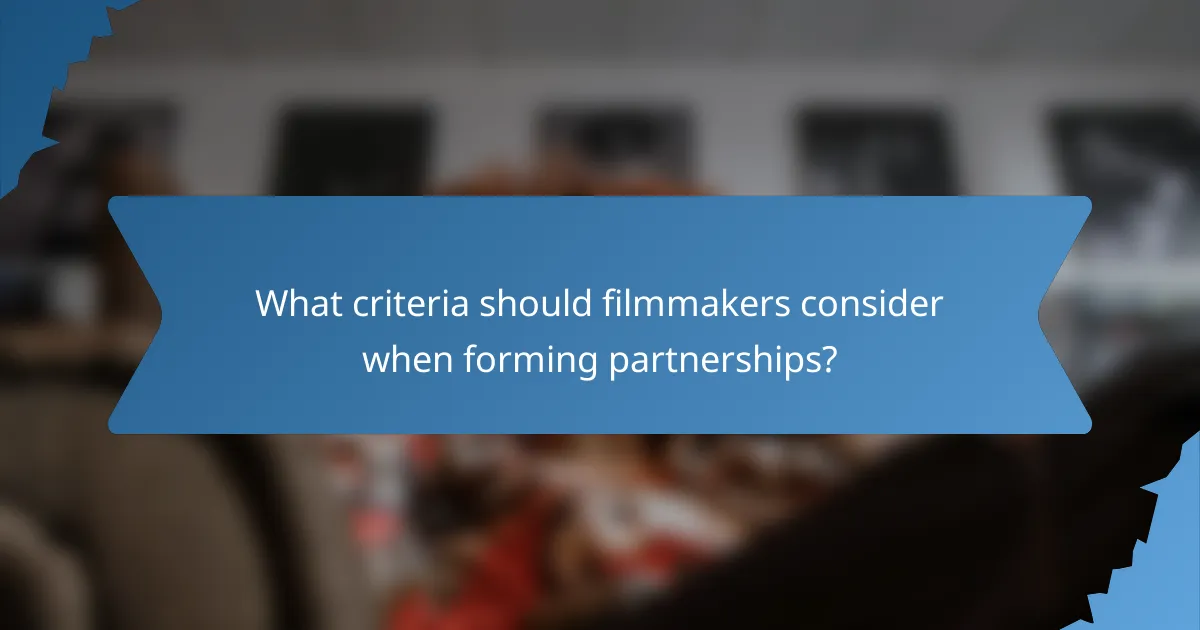Collaborative activist films play a crucial role in enhancing partnerships by fostering a shared vision among diverse stakeholders and pooling resources effectively. By creating a platform for collective storytelling, these films amplify voices and drive social change, ultimately engaging audiences in meaningful ways. Effective partnership models, such as co-production agreements and community-based collaborations, facilitate resource sharing and align efforts to maximize impact.

How can collaborative activist films enhance partnerships in the UK?
Collaborative activist films can significantly enhance partnerships in the UK by fostering a shared vision among diverse stakeholders, pooling resources, and engaging audiences more effectively. These films create a platform for collective storytelling that amplifies voices and drives social change.
Increased audience engagement
Collaborative activist films often attract a wider audience by integrating various perspectives and narratives. This engagement can be enhanced through community screenings, social media campaigns, and interactive discussions, which encourage viewers to connect with the issues presented.
To maximize audience involvement, filmmakers should consider utilizing local events or festivals as platforms for showcasing their work. Engaging with local communities not only builds interest but also fosters a sense of ownership among viewers.
Shared production costs
Pooling resources among collaborators can significantly reduce production costs for activist films. By sharing expenses related to equipment, locations, and personnel, partners can create high-quality content without the financial burden typically associated with independent filmmaking.
Filmmakers should establish clear agreements on cost-sharing upfront to avoid misunderstandings. Utilizing local grants or crowdfunding initiatives can also provide additional financial support, making the project more sustainable.
Access to diverse resources
Collaborative projects benefit from the diverse skills and resources of each partner, including technical expertise, funding opportunities, and networks. This diversity can enhance the film’s quality and reach by incorporating varied viewpoints and experiences.
To effectively leverage these resources, partners should conduct a thorough assessment of each other’s strengths and capabilities. Regular communication and coordination are essential to ensure that all resources are utilized efficiently and contribute to the project’s goals.

What are effective partnership models for activist films?
Effective partnership models for activist films include co-production agreements, community-based collaborations, and NGO partnerships. These models facilitate resource sharing, align visions, and enhance the impact of the film through combined efforts.
Co-production agreements
Co-production agreements involve two or more entities collaborating to produce a film, sharing both the financial and creative responsibilities. This model allows for pooling resources, such as funding, talent, and equipment, which can significantly reduce costs and increase production quality.
When entering a co-production agreement, it’s crucial to clearly define roles, responsibilities, and profit-sharing arrangements. Consider drafting a formal contract that outlines these elements to prevent misunderstandings later on.
Community-based collaborations
Community-based collaborations engage local groups and individuals in the filmmaking process, ensuring that the film reflects their perspectives and needs. This model fosters a sense of ownership and can lead to more authentic storytelling.
To establish effective community collaborations, start by identifying key stakeholders and conducting outreach to understand their interests. Regular meetings and feedback sessions can help maintain alignment and build trust throughout the project.
NGO partnerships
Partnering with non-governmental organizations (NGOs) can amplify the reach and impact of activist films. NGOs often have established networks and expertise in advocacy, which can enhance the film’s messaging and distribution.
When collaborating with NGOs, ensure that their mission aligns with your film’s objectives. Discuss how both parties can benefit from the partnership, whether through shared resources, audience engagement, or joint promotional efforts.

How does resource pooling benefit activist film projects?
Resource pooling in activist film projects allows collaborators to share financial, human, and material resources, enhancing the overall impact and reach of their work. By combining efforts, filmmakers can reduce costs, access a wider range of skills, and improve distribution channels.
Cost efficiency
Pooling resources significantly enhances cost efficiency for activist film projects. By sharing expenses such as equipment, locations, and personnel, collaborators can lower individual financial burdens, making it easier to allocate funds to critical areas like marketing and outreach.
For example, a group of filmmakers might share a single camera setup instead of each purchasing their own, saving thousands of dollars. This collective approach can also lead to negotiating better deals with vendors or service providers due to increased purchasing power.
Broader skill sets
Collaborative projects benefit from a diverse range of skills brought together through resource pooling. Each participant contributes unique expertise, whether in cinematography, editing, sound design, or community engagement, leading to a richer final product.
For instance, one filmmaker might excel in storytelling while another has strong technical skills. This combination enhances the overall quality of the film, as different perspectives and talents can address various aspects of production more effectively.
Enhanced distribution networks
Resource pooling can significantly enhance distribution networks for activist films. Collaborators often have their own established connections within different communities and platforms, which can be leveraged to reach wider audiences.
For example, one filmmaker might have access to local film festivals while another has connections with online streaming platforms. By working together, they can create a more comprehensive distribution strategy that maximizes visibility and impact for their cause.

What shared visions drive successful activist films?
Successful activist films are driven by a shared vision that aligns the goals and values of all collaborators involved. This collective purpose fosters a strong narrative that resonates with audiences and amplifies the intended message.
Common social goals
Common social goals serve as the foundation for collaborative activist films. These goals often focus on pressing issues such as environmental sustainability, social justice, or human rights. By identifying and agreeing on these objectives, partners can create a cohesive film that effectively communicates their message.
For instance, a film addressing climate change may unite filmmakers, scientists, and activists who share a commitment to environmental advocacy. This alignment ensures that the film not only entertains but also educates and inspires action among viewers.
Collective storytelling
Collective storytelling involves pooling diverse perspectives and experiences to create a richer narrative. This approach allows filmmakers to incorporate various voices, making the film more relatable and impactful. By collaborating, partners can weave together personal stories that highlight the broader social issues at hand.
An example of this can be seen in documentaries that feature interviews with affected communities, activists, and experts. This multifaceted storytelling enhances the film’s authenticity and engages audiences on an emotional level.
Unified messaging strategies
Unified messaging strategies are crucial for ensuring that all promotional efforts align with the film’s core message. This involves coordinating marketing campaigns, social media outreach, and public relations to maintain consistency. Clear messaging helps to reinforce the film’s themes and encourages audience engagement.
For effective messaging, partners should develop a shared communication plan that outlines key messages, target audiences, and promotional tactics. Regular check-ins can help maintain alignment and adapt strategies as needed, ensuring that the film reaches its intended impact.

What criteria should filmmakers consider when forming partnerships?
Filmmakers should consider alignment of values and complementary expertise when forming partnerships. These criteria ensure that all parties share a common vision and bring unique skills to the project, enhancing the overall effectiveness and impact of the film.
Alignment of values
Alignment of values is crucial for successful partnerships in filmmaking. When all partners share similar beliefs and goals, it fosters a collaborative environment where creative ideas can flourish. For instance, if a project aims to raise awareness about climate change, partners should be committed to environmental sustainability.
To assess alignment, filmmakers can discuss their mission statements, project goals, and ethical considerations upfront. This dialogue helps identify any potential conflicts and ensures that everyone is on the same page, ultimately leading to a more cohesive project.
Complementary expertise
Complementary expertise involves bringing together individuals with different skills and experiences that enhance the filmmaking process. For example, a filmmaker with a strong background in storytelling may partner with a cinematographer known for technical prowess. This combination can elevate the film’s quality significantly.
When forming partnerships, consider the specific skills each partner brings to the table. Create a list of required roles, such as directing, editing, or marketing, and identify individuals who excel in those areas. This strategic approach maximizes the strengths of each partner and minimizes weaknesses.
